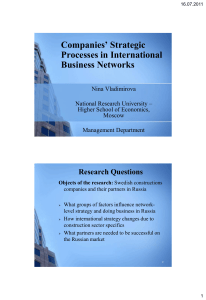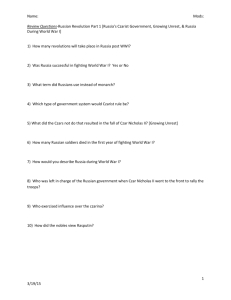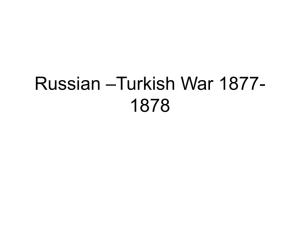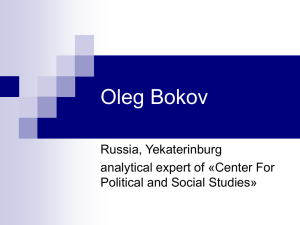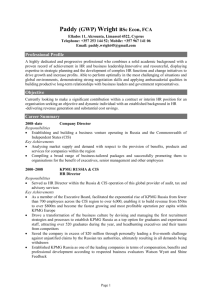Role of Long-term Gas Contracts on EU-Russia Energy Relations Introduction
advertisement
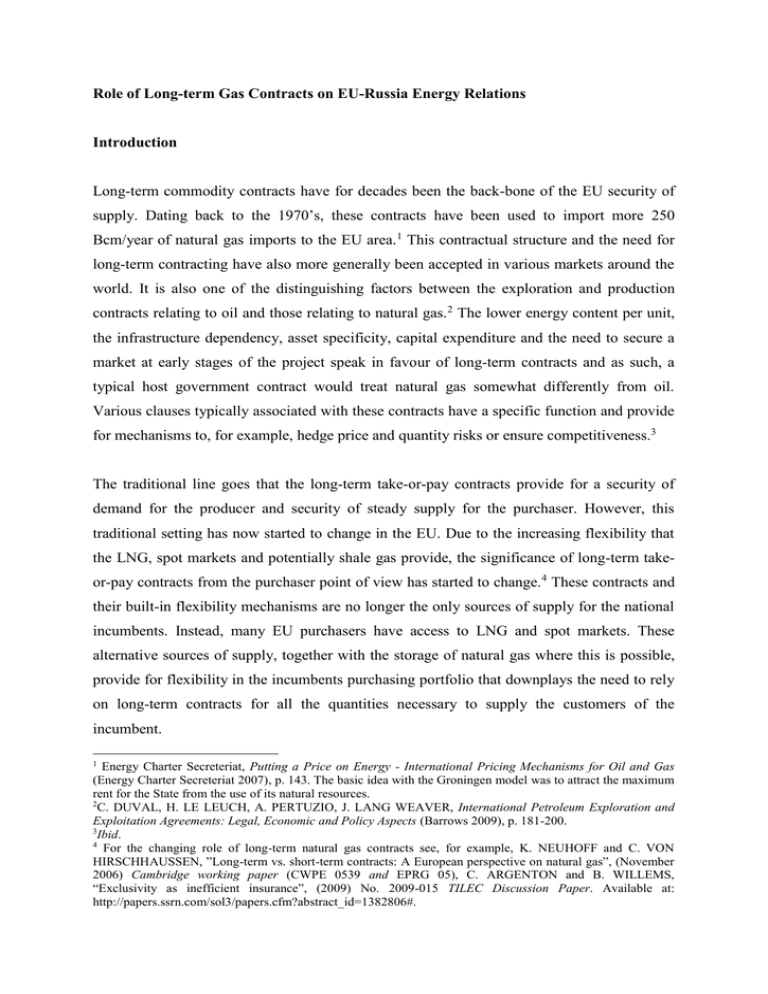
Role of Long-term Gas Contracts on EU-Russia Energy Relations Introduction Long-term commodity contracts have for decades been the back-bone of the EU security of supply. Dating back to the 1970’s, these contracts have been used to import more 250 Bcm/year of natural gas imports to the EU area.1 This contractual structure and the need for long-term contracting have also more generally been accepted in various markets around the world. It is also one of the distinguishing factors between the exploration and production contracts relating to oil and those relating to natural gas.2 The lower energy content per unit, the infrastructure dependency, asset specificity, capital expenditure and the need to secure a market at early stages of the project speak in favour of long-term contracts and as such, a typical host government contract would treat natural gas somewhat differently from oil. Various clauses typically associated with these contracts have a specific function and provide for mechanisms to, for example, hedge price and quantity risks or ensure competitiveness.3 The traditional line goes that the long-term take-or-pay contracts provide for a security of demand for the producer and security of steady supply for the purchaser. However, this traditional setting has now started to change in the EU. Due to the increasing flexibility that the LNG, spot markets and potentially shale gas provide, the significance of long-term takeor-pay contracts from the purchaser point of view has started to change.4 These contracts and their built-in flexibility mechanisms are no longer the only sources of supply for the national incumbents. Instead, many EU purchasers have access to LNG and spot markets. These alternative sources of supply, together with the storage of natural gas where this is possible, provide for flexibility in the incumbents purchasing portfolio that downplays the need to rely on long-term contracts for all the quantities necessary to supply the customers of the incumbent. 1 Energy Charter Secreteriat, Putting a Price on Energy - International Pricing Mechanisms for Oil and Gas (Energy Charter Secreteriat 2007), p. 143. The basic idea with the Groningen model was to attract the maximum rent for the State from the use of its natural resources. 2 C. DUVAL, H. LE LEUCH, A. PERTUZIO, J. LANG WEAVER, International Petroleum Exploration and Exploitation Agreements: Legal, Economic and Policy Aspects (Barrows 2009), p. 181-200. 3 Ibid. 4 For the changing role of long-term natural gas contracts see, for example, K. NEUHOFF and C. VON HIRSCHHAUSSEN, ”Long-term vs. short-term contracts: A European perspective on natural gas”, (November 2006) Cambridge working paper (CWPE 0539 and EPRG 05), C. ARGENTON and B. WILLEMS, “Exclusivity as inefficient insurance”, (2009) No. 2009-015 TILEC Discussion Paper. Available at: http://papers.ssrn.com/sol3/papers.cfm?abstract_id=1382806#. The changing role of long-term contracts and the uncertainty that the EU energy market liberalisation has created is, understandably, causing concerns for some producers, Gazprom in particular. For the producing countries, the revenue from hydrocarbons, be it oil or natural gas, is often the main source of government income. Russia and Algeria are not exceptions to this. While Algeria is major LNG exporter, thus capable of taking advantage of the flexibility of the LNG trade5, Russia and Gazprom are still largely relying on its EU customers and EU purchases. While there are new projects that take advantage of the more flexible international LNG trade, such as the Sakhalin projects6, and even if the diversification to China is slowly emerging,7 Russian gas exports are still mainly directed to the EU member states. Also, the volumes transported to China would not have been transported to EU in any case, due to the geographical location of the natural gas fields that will supply China. The response of these producers have been twofold: on the other hand, they are taking steps to counter some of the negative effects of the liberalisation and on the other, they are attempting to take advantage of the opportunities liberalisation provides. However, neither of the two is being well received by the EU member states.8 However, despite of the recent changes in the natural gas markets, EU 27 is a net importer of natural gas, increasingly dependent on a very few producing countries. While some EU Member States, the UK and the Netherlands in particular, possess natural gas resources and other have potential for developing non-conventional natural gas resources, the bulk of natural gas for the EU comes from three sources: Russia (42 percent), Norway (24 percent), Algeria (18 per cent).9 However, it must be noted that these percentages represent only the imports. The indigenous production in the EU represents 36 percent of the total supplies and together with Norwegian supplies the figure is 55 per cent. 10 Even with the potential emergence of shale gas, the picture is unlikely to change dramatically. 11 Similarly, the demand for gas is already showing signs of recovering demand.12 5 The emergence of shale gas in the US and potentially in the EU, can also complicate the economics of LNG trade. 6 http://gazprom.com/production/projects/deposits/sakhalin2/. 7 http://www.gazprom.com/press/news/2009/october/article69166/. 8 The reference is to the concerns over the creation of a “Gas OPEC” and to the “Gazprom clause” in the third energy law package. 9 Commission Staff Working Document accompanying the Second Strategic Energy Review, Europe's current and future energy position Demand – resources – investments 13.11.2008 (COM/2008/781 final), p. 9. 10 Eurogas, Long Term Outlook for Gas Demand and Supply 2007-2030. Available at www.eurogas.org. 11 Eurogas, Long Term Outlook for Gas Demand and Supply 2007-2030. Available at www.eurogas.org. 12 http://gazprom.com/press/news/2010/june/article100343/. This paper will examine the approach of the main stakeholders of the EU-Russia energy trade toward long-term natural gas contracts; the impact of these contracts and partially conflicting views on the EU-Russia energy relationship and the impact of these two issues, conflicting views and the need to maintain the relationship, on the EU energy acquis. As will be seen, while most stakeholders recognise the need for some degree of long-term contracting, these contracts are a continuous source of controversy on both commercial and institutional level. EU-Russia natural gas trade: Multilevel dynamics The European trade in natural gas has two main components: an economic or commercial component and a political component. One of the main factors highlighting the political component is the strategic importance of natural resources like natural gas, and the need to extract as much rent as possible from the sales of the natural resource before its depletion. This is reflected in the degree of control that the producing state has over its natural resource industry. In case of Russian and Algerian supplies, the companies are, fully or partially, owned and controlled by the State and State policies can, and do, influence the decision making of the respective companies, Gazprom and Sonatrach. Another factor is the peculiar characteristic of the EU natural gas market where the producers are not under the direct influence of the EU law. These producing countries are not, and will not be, EU member states and there are no indications that these countries would accept to comply with the EU energy acquis or join the Energy Community Treaty, instead they view the acquis as a way to discriminate against the major energy suppliers. However, this is not true for Norway, but with Norway, the political issues are much less complicated than with Russia or Algeria. Because of this dual nature of the natural gas trade, a study of this area must recognise both aspects and approach the natural gas trade from both a commercial and a political angle. In addition, there are legal issues affecting both components.13 Given the different elements of natural gas trade, it is also possible to distinguish between various levels in the relationship between the producing companies and their EU customers. First, there exists a commercial relationship between producers, Gazprom and Sonatrach, and their EU customers, E.ON Ruhrgas or GDF Suez, for example. This relationship is built on long-term contracts, shareholdings, asset swaps and other commercial dealings. In addition to 13 These issues are examined in detail in K. TALUS, Vertical natural gas transportation capacity, upstream commodity contracts and EU competition law (Kluwer Law International, forthcoming) this commercial relationship, there is an institutional relationship between the producing State and the EU. This institutional relationship is built of various cooperative organs such as EURussia Energy Dialogue, Partnership Agreements and Neighbourhood Policies. As a part of the institutional level, there is a political relationship between the parties. This relationship takes place on multi-lateral and bi-lateral political level. The cooperation on various levels is different in terms of actors, outcomes, methods and dynamics of cooperation. Also the objectives on different levels are partially different. While the commercial dealings between companies aim at meeting commercial targets, increased sales and company value, the objectives at institutional level include issues like security of supply and demand and other benefits to the state. Obviously, these aims are distorted by other objectives. Given the multilevel dynamics of the EU-Russia natural gas trade, there is a risk of discrepancy in the aims, dynamics and the dialogue on different levels. In the EU-Russia scenario, this seems to take place primarily on the EU side. Looking at the approach to longterm natural gas contracts used to import natural gas to the EU area, it is clear that the logic of Commission and many of the European energy companies are in contradiction. The Commission, while recognising the role of long-term energy agreements, favours shorter term trading over longer term arrangements. Private companies have only marginally exploited the possibilities that short term trading has to offer and tend to prefer the traditional approach; long-term agreements. This is only logical as the change of paradigm –from State to Market – has taken place only on the EU side and the interests of the State and the interest of the energy companies no longer necessarily coincide. However, on the Russian side, as with most producing states, the relationship between the State and Gazprom are closer and their interests more aligned. However, it is important to note that the relationship between private and public sector and the role of the public sector in the EU is not very clear at the moment and conflicting signals have been created. It seems that in some ways the traditional role of the states in supporting their energy companies, has not disappeared but has instead been absorbed by the European Commission. A good example of this shift of power from the states to the European Commission is the Nabucco project and the role of the Commission in facilitating the project.14 Nevertheless, the difference in the ideology, more market based system vis-a-vis a more State centered system, explains why the Russian side is more united than the EU side in its dealings with its partner. The next section will now focus on the different views of some of the stakeholders in the EURussia natural gas trade: Gazprom and the Russian State, EU companies and the European Commission. Views from parties Long-term natural gas contracts affect the EU-Russia relationship on various levels and play a role in the dynamics at these levels. At commercial level, the role of long-term contracts is mainly positive, on an institutional level it is a source of complications. Russia and Gazprom For Gazprom, the approach to long-term contracts has been very clear. The company has a clear preference for this kind of contracts between the upstream producers and the first purchasers in the EU.15 In its 2009 General Shareholder Meeting, Gazprom underlined this again by noting that ”As an economically efficient company Gazprom assumes that gas should be sold first and then produced and conveyed, and therefore the implementation of projects is linked to the confirmed prospective demand for gas.”16 Very clearly, this means that from Gazprom point of view, the EU-Russia natural gas trade in the near and medium term future will be based on long-term contracts. EU Companies The approach of EU natural gas companies to long-term contracts in the EU-Russia natural gas trade is not uniform. For very understandable reasons, the approach to long-term contracts is mixed, in simplified terms: incumbents in favour (noting issue like investment 14 Here, the passivity of the US has been remarkable. The long-term goal of the US has been to assist the Caspian region to wean away from the Russia influence. This policy objective was particularly visible in the BTC pipeline project where US administration used its political power to push the project ahead. 15 www.gazprom.com/eng/articles/article20160.shtml. 16 http://gazprom.com/press/news/2010/june/article100343/. incentives, encouraging the external producers to supply the EU rather than other countries, ability to stabilise the price for natural gas, necessary flexibility in their purchase and storage portfolio), new entrants somewhat less favourable (noting issues like foreclosure, internalising the role of the wholesale markets, price and volume risk). The difference of approach stems from the foreclosing effect of large volume long-term contracts. For incumbents, they provide for security not only in terms of supplies, but also in terms of market shares. For new entrants, they cause output foreclosure and thus limit the possibilities to a successful entry. The EU Commission Here the initial view of the Commission towards long-term contracting, largely following certain merger cases17, was negative and the idea of foreclosure was dominating. To no surprise, this view was rigorously opposed by the gas industry, particularly by Gazprom,18 and, following various speeches and threats to energy security, the Commission modified its view.19 The Commission has now recognised that long-term contracts have an important role to play in European gas markets and should be left as an option for the suppliers as long as they comply with EU regulation and especially EU competition laws.20 On the general EU level, the Security of Gas Supply Directive confirmed this, explicitly recognising the link between long-term gas supply agreements and security of supply: Long-term contracts have played a very important role in securing gas supplies for Europe and will continue to do so. The current level of long term contracts is adequate on the Community level, and it is believed that such contracts will continue to make a In particular, IV/M.1383 – Exxon/Mobil. J. STERN, The future of Russian gas and Gazprom (OUP 2005), p. 131 – 132. 19 See also J. STERN, The future of Russian gas and Gazprom (OUP 2005), p. 148. This change in the Commission opinion may well be a result of increased understanding of the dynamics of the natural gas market. 20 This has been noted, for example, in the Second Gas Market Directive, preamble 25, Security of Gas Supply Directive, preambles 8 and 11, Communication from the Commission, Inquiry pursuant to Article 17 of Regulation (EC) No 1/2003 into the European gas and electricity sectors (Final Report) COM(2006) 851 final p. 10, the Communication from the Commission to the Council and the European Parliament also recognises that despite many positive effects, long-term agreements also serve to foreclose markets; Communication from the Commission to the Council and the European Parliament – Prospect for the internal gas and electricity market, (COM(2007) yyy final), p. 16. 17 18 significant contribution to overall gas supplies as companies continue to include such contracts in their overall supply portfolio.21 The January 2007 outlook from the Commission repeats these considerations but also alludes to the negative effects these contracts regularly have on EU energy markets in the form of foreclosure.22 In a press release relating to the 2005-2007 Sector Inquiry, the Commission laid out its view on long-term commodity contracts, which still seems to be valid: “Long contract duration is not, in itself, anti-competitive. It is established Commission policy that long term import contracts have an important role to play when it comes to ensuring Europe’s security of supply. However, where a significant proportion of the gas that can come to the market is locked in for the long-term, the cumulative effect might be that new entrants are excluded from the market. Individual terms and conditions contained in such contracts may also be anti-competitive: e.g. territorial restrictions are generally viewed negatively under Community competition rules. However, legitimate needs to underpin large investments with certain long-term contracts, must be taken into account”.23 This press release explains several issues that have been confirmed in the subsequent case law from the Commission. First, the long duration of the contracts is not anticompetitive. Instead, the volumes that these contracts cover are the key issue. Second, specific clauses contained in these contracts are potentially anticompetitive. Long-term contracts and EU-Russia energy relationship: Institutional Level 21 Directive 2005/89/EC of the European Parliament and of the Council of 18 January 2006 concerning measures to safeguard security of electricity supply and infrastructure investment, OJ L 33, 4.2.2006, p. 22-27, preamble 11. As was seen before, this was also noted in all three Gas Market Directives. 22 Communication from the Commission to the Council and the European Parliament – Prospects for the internal gas and electricity market (COM/2006/841 final), Brussels, 10 January 2007 at 2.3.2 23 Energy sector competition inquiry – final report – frequently asked questions and graphics (MEMO/07/15, 10.1.2007.) On the institutional level the traditional long-term contracts have been a source of controversy.24 One of the primary forums in the EU-Russia energy relations is the Energy Dialogue that was initiated in October 2000. The basic idea behind this energy-focused cooperation was that energy was far too important a subject for both the EU and Russia to be left to one article in the Partnership and Cooperation Agreement. 25 This Dialogue covers issues such as energy security, energy efficiency, infrastructure, investment and trade. This cooperation represents a policy level cooperation and the actual decision-making powers of the States involved are not affected in any way. The stated objective of this partnership is to promote energy security on the European continent. While the Energy Dialogue may cover a wide range of issues, there are clear differences in emphasis between the parties: while the EU is mainly addressing issues of access to Russian markets and security of EU energy supply, Russia seems to be concerned over investment to export infrastructure. At least in part because of these differences, the success of the Energy Dialogue in the natural gas area has been limited. 26 While this partnership might be beneficial for both parties, it still faces significant challenges. Some of the current issues that the co-operation with Russia faces is the gradual foreclosure of investments from companies established in one of these areas to the other area. Russia has limited the participation of foreign investors in developing its natural resource base and the EU has, through the Third Country Clause,27 done virtually the same.28 It was specifically noted by the Russian representatives at a meeting as a “potential” issue that could impair further co-operation. Similarly, environmental issues continue to be a difficult area.29 24 For a detailed account of legal, political and economic questions relating to long-term natural gas import agreements and their relationship to transportation capacity agreements, see K. TALUS, Vertical natural gas transportation capacity, upstream commodity contracts and EU competition law (Kluwer Law International, forthcoming). 25 S. S. HAGHIGHI, Energy Security: The External Legal Relations of the European Union with Major Oil and Gas Supplying Countries (Hart Publishing 2007), p. 344. 26 One of the more recent elements of the Dialogue is the so-called Early Warning Mechanism that requires mutual information sharing in case of potential oil and gas supply and demand problems, including transit. Such problems may be technical, commercial or political in nature. On this and other developments, see http://ec.europa.eu/energy/russia/overview/index_en.htm. 27 For the Third Country Clause and its relation to international law and EU – Russia relations, see A. WILLEMS, J. SUL and Y. BENIZRI, Unbundling as a Defence Mechanism Against Russia: Is the EU Missing the Point?”, in K. TALUS and P. FRATINI, EU – Russia Energy Relations (Euroconfidential 2010) and S. S. HAGHIGHI, ”Establishing an External Policy to Guarantee Energy Security in Europe? A Legal Analysis”, in M. ROGGENKAMP and U. HAMMER, European Energy Law Report VI (Intersentia 2009). 28 http://ec.europa.eu/energy/russia/joint_progress/doc/progress9_en.pdf. 29 Ibid. Long-term contracts have also been discussed in the context of the Energy Dialogue and while some issues were resolved or at least facilitated, many other issues have remained unresolved. The primary example, perhaps the only example, of the beneficial effect of the Dialogue is the resolution of the destination clause issue.30 In addition to this success, longterm contracts have been discussed in the Energy Dialogue without tangible results. For example, the Interim Report of the Parties to the EU-Russia Energy Dialogue of 2006 recognizes that long-term gas supply contracts play an important role in facilitating investments to exploration, production and transport of natural gas.31 Similarly, the 2008 Report notes that the “guaranteed volume of Russian gas export [to the EU] would depend on the contracted demand for Russian gas on the side of European consumers.”32 While the first note clearly originates from the EU side, the second is a Russian note. The Energy Dialogue is not the only attempt to overcome the difficulties in the EU-Russia relationship. On the contrary, various cooperative mechanisms such as the Partnership and Cooperation Agreement, the EU-Russia Energy Dialogue, Association Agreements, Neighbourhood Policies or Strategic Energy Partnerships have been created.33 The tangible effects of these mechanisms have not been very significant and as was most recently seen in the context of the Energy Charter Treaty and the Russia’s notification that it did not intend to become a contracting party to the ECT, thus effectively ending the provisional application of the ECT on the 18 October 2009, these mechanisms are unable to provide for their intended results. While not directly behind the above notification, the long-term contracts were a controversial issue also for the Russian ratification of the ECT and the Transit Protocol. Before the Russian notification that it would not ratify the ECT and would cease to apply the ECT provisionally,34 the most significant issues were: (I) the Regional Economic Integration 30 EU-Russia Energy Dialogue, The Second Progress Report, May 2008. Available at: http://ec.europa.eu/energy/international/bilateral_cooperation/russia/doc/reports/progress2_en.pdf. 31 Interim Report by the Parties of the EU-Russia Energy Dialogue, para. 3. Available at: http://ec.europa.eu/energy/russia/joint_progress/doc/2006_05_25_interim_report_en.pdf. 32 The ninth Progress Report, October 2008. Available at: http://ec.europa.eu/energy/russia/joint_progress/doc/progress9_en.pdf. 33 For an account on the effects of these measures to the EU-Russia relationship, see A. KONOPLYANIK, ”A Common Russia EU Energy Space (The New EU Russia Partnership Agreement, Acquis Communautaire, The Energy Charter and the New Russian Initiative)”, in K. TALUS and P. FRATINI, EU – Russia Energy Relations (Euroconfidential 2010). 34 Notification and various commentaries are available at www.ogel.org. Organisation clause (REIO),35 (II) the issues relating to access to pipelines and tariff-setting procedure (including the questions regarding auctions) and (III) the right of first refusal on renewal of transit terms for existing users.36 For the third item, Russia is insisting on the right of first refusal, the idea being that an existing shipper with a long-term gas contract should have the opportunity to prolong access to transit capacities when his transit contract expires. In the Russian opinion, the absence of this provision means that the Russian exporter, Gazprom, has a significant risk of losing access to the transportation capacities, which would translate into the impossibility of fulfilling the long-term supply agreement.37 The Commission, on the other hand, opposes the provision, noting that the EU may only apply this kind of right to the existing Russian supply contracts, but not to future contracts within EU territories.38 As most of the questions relating to long-term contracts remained unresolved at political or institutional level, the effect of these contracts are arguably mainly negative. In practise, they have caused great difficulties on the EU side where the Commission has been obliged to find ways to combine the need to apply laws, competition laws in particular, while recognising the political realities of the EU-Russia energy relationship. There are no indications that this reality would change. On the contrary, due to factors like the general difficulties in the political relationship between the Western European countries and Russia, the degree of suspicion of the new member states, largely following the historical reasons and events like the gas supply cuts of 2006 and 2009, the political aspects of the trade in natural gas are going to dominate the legal issues in the short and medium term. Recent developments: light in the end of the tunnel 35 It seems that while the two other points may be overcome through negotiations, the REIO clause is the most difficult item to resolve. The EU refuses to allow the Transit Protocol to be applicable to transport within the EU area. 36 For an explanation of these difficulties see, for example, C. BAMBERGER and T. WÄLDE, ”The Energy Charter Treaty”, in M. ROGGENKAMP et al. (Eds.), Energy Law in Europe (OUP 2008) and D. DOEH, A. POPOV and S. NAPPERT, ”Russia and the Energy Charter Treaty: Common Interests or Irreconcileable Differences?”, 5 (2007) 2 OGEL. 37 T.I. SHTILKIND, ”Energy Charter Treaty: A critical Russian perspective”, 2 (2005) 3 TDM. 38 See A. KONOPLIANIK, ”Stiff Competition Ahead – As Russia moots Ways to increase Presence on European gas Market”, Oil, Gas & Energy Law Intelligence (2004) Vol 2, issue 1 OGEL. See also ”Putting a Price on Energy: International Pricing Mechanisms for Oil and Gas”, (2007) Energy Charter Treaty Secretariat, p. 174 and D. DOEH, A. POPOV and S. NAPPERT, ”Russia and the Energy Charter Treaty: Common Interests or Irreconcileable Differences?”, 5 (2007) 2 OGEL. The European Commission has over the recent years intensified its efforts to create a change in the EU natural gas markets on the back of the general competition law, together with its efforts on the regulatory front. Starting from destination clauses and downstream contracts, the focus of the Commission has moved towards more complex issues such as ownership unbundling and major capacity releases. Here, the GDF Suez39 and E.ON40 decisions and the 50 per cent capacity releases are a significant step forward in promoting access to networks which will in turn help delivering greater competition. Even with the increasingly powerful competition law enforcement, the Commission has not acted against the wide use of long-term take-or-pay contracts, with the exception of the destination clauses41, or specific clauses they contain, to import natural gas to the EU, despite the continuous references to the need to comply with EU competition law. Nor has engaged into a detail examination of the economics of the upstream commodity contracts used to import natural gas to the EU, at least publicly. The aim here is not to provide criticism towards this approach. On the contrary, the author very much agrees with the continuing validity of these contracts and allowing the importers to use these contracts as part of their purchasing portfolio. However, there is room for criticism when it comes to the transparency of the EU and the Commission policy vis-a-vis these contracts. Much like was done with downstream contracts, further guidance for the industry should be provided. Looking at the downstream cases42, it seems rather clear that the long-term nature of these upstream take-or-pay contracts is not at stake in any scenario. It is rather the combination of long-term nature and very significant volumes, coupled with certain specific clauses, which are capable of having an anticompetitive effect. The initial negative view of the Commission towards long-term contracting, has been superseded by a more profound understanding of the economics of the energy markets. Reflecting the more general trend towards a more economics based approach instead of rigid per se rules, the European Commission has now COMP/39.316 – GDF foreclosure. COMP/39.317 E.On gas foreclosure. 41 For example, COMP/38.085 - PO/Territorial restrictions – Austria, COMP/37.811 - Territorial Restrictions 1) Algerian gas export contracts 2) Expansion of TAG pipeline. Also, Commission press release, “Commission secures changes to gas supply contracts between E.ON Ruhrgas and Gazprom”, (IP/05/710), 10 June 2005. 42 COMP/B-1/37966 – Distrigaz in particular but also COMP/37.542 - Gas Natural + Endesa and Bundeskartellamt, Bundeskartellamt pushes ahead with competition in the gas market (28.1.2005). for an analysis of the downstream cases, see A. DE HAUTECLOCQUE, “EC Antitrust Enforcement in the Aftermath of the Energy Sector Inquiry: A Focus on Long-term Supply Contracts in Electricity and Gas”, in B. DELVAUX, M. HUNT and K. TALUS (eds.), EU Energy Law and Policy Issues (Euroconfidentiel 2008). 39 40 recognised that long-term contracts are not always anticompetitive but create efficiencies that out-weigh the negative effects.43 For both the upstream long-term take-or-pay contracts and the pre-liberalisation transit contracts, there are also additional geopolitical considerations that much be recognised and factored into the competition law assessment of these contracts. The involvement of upstream producers creates an additional level of complication. These complications have had their effect in the Commission enforcement practise, an example being the destination clause saga where the application of EU competition law had to be compromised in cases involving an external supplier.44 Resource ownership and international political considerations triumph the “normal” application of EU competition laws. However, instead of camouflaging or hiding this geopolitical - “they have the gas, we do not” – factor, a clear method should be adopted. This method should accommodate the expectations and balance the interests of both the EU and its external suppliers. As was seen above, the Commission has moved from a negative to a more positive view when it comes to long-term contracts. For the last years, it has consistently held that longterm contracts are allowed, as long as they comply with EU competition law. The problem from a legal certainty point of view has been the remark “as long as they comply with EU competition law”. The most recent case law from the Commission has finally shed some light to this condition. The compromise between positive and negative aspects of long-term contracting, now clearly being pushed by the European Commission, is that the long-term upstream commodity contracts are left as an option to the EU energy companies and, instead, foreclosure is addressed through attacking capacity contracts. 45 Instead of supply related foreclosure, the Commission has attacked the network related foreclosure. Here, import capacity is of particular interest. The Commission recognises the beneficial security effect of long-term upstream commodity contracts and limit the possibility of the incumbent to reserve transportation capacity. In the Nabucco case, the right of dominant companies to reserve exit capacity was limited to 50 per cent.46 The underlying rationale was to avoid a situation where the dominant position was reinforced and to allow for new players to benefit from the project. This was in particular apparent in the downstream contract cases like COMP/B.1/37.966 – Distrigaz. K. TALUS, ”Long-term gas agreements and security of supply – between law and politics”, European Law Review 32 (2007). 45 It should however be recognized that this approach might indirectly affect the long-term commodity contracts and will probably result in increasing anxiety from the upstream producers. 46 Commission exemption decision in Nabucco (CAB D/2008/142), 8 February 2008. 43 44 Most recently, a similar approach has been adopted in the case relating to the OPAL pipeline.47 In GDF Suez,48 the commitments proposed by the company and later accepted by the Commission have a similar effect. The right of the incumbent to reserve capacity at import points is limited to 50%. The E.ON case reinforces the trend.49 This policy choice will circumvent, or at least alleviate, the political difficulties connected with the long-term upstream commodity contracts and may, if properly overseen by the authorities, could have largely the same effect. However, it must be recognised that the practical effects of the introduction of the capacity cap are somewhat uncertain and to be successful, require close supervision from the European Commission. For example, one possible outcome is that the incumbents are able to renegotiate their contracts with external producers who in turn enter the downstream markets themselves and thus become the new entrants. Other possible scenarios are that the incumbents use artificial methods to circumvent the capacity cap through the use of swaps, using each other’s transport capacity or other possible options they might have. Because this second danger, incumbents taking bilateral or coordinated measures to bypass the 50 per cent capacity cap, the supervision of the markets and commitments would be of primary importance for the next years. The first option, external producers entering the downstream market could create addition competition but could from a political perspective be difficult for most of the member states to accept. The Third Country Clause of the Third Package, the so-called Gazprom clause, is an illustration of this. Conclusion The EU natural gas markets are once again experiencing significant changes: the emergence of shale gas in the US not only stopping the increasing number of LNG shipments into the US or the Canadian pipeline imports but also turning some of the re-gasification terminals along the US coast from import to export terminals; potential discoveries of non-conventional gas in the EU, Poland in particular, and the dramatic drop in the EU natural gas demand. 47 Legal proceedings relating to this decision have been initiated before the General Court on the 25 September 2009. See case T-381/09, RWE Transgas v Commission. 48 COMP/39.316 – GDF foreclosure. 49 Commission press release, “Antitrust: E.ON's commitments open up German gas market to competitors” (IP/10/494), 4 May 2010. Increased volumes of inexpensive natural gas together with a decreased EU demand have created a situation of oversupply of natural gas, at least temporarily. The changing market situation has not come without consequences to the dynamics of the producing – consuming country relationship. This does not only concern the subject matter of this particular paper but is more general. The powers of the producing countries vis-a-vis the consuming countries are reduced at times of lower prices and reduced demand. Looking at the past developments of the hydrocarbon industry and the relationship between producing states and consuming states, the current situation will not last but the pendulum is bound to swing back in favour of the producing states.50 Unlike the economic slowdown, the emergence of significant volumes of unconventional gas might have a longer lasting effect. These developments have various consequences on the EU natural gas trade and for longterm contracts as an integral component of that trade. Increased volumes of LNG are available for the EU purchasers. This provides for flexibility in the purchasing portfolio of the EU companies. It has had a positive effect on short-term trading. Increased volumes of spot gas are available at various EU natural gas hubs. These developments have lead to increased demands for de-linking the oil and gas prices are voiced and cheap gas is flowing in.51 Despite of this, long-term contracts continue to be the backbone of the EU natural gas trade. There is no doubt that these contracts and their specific clauses will undergo a change 50 Also, it is necessary not to overestimate the effect of the reduced demand and the resulting gas glut on the EU-Russia relationship. 51 Eurogas, Long Term Outlook for Gas Demand and Supply 2007-2030. Available at www.eurogas.org. in the mid-term. Destination clauses have already been eliminated, except from certain LNG contracts. Oil-gas indexation will disappear, the contractual volumes will be reduced and short-term spot trade will replace some of the long-term trading. In the mean time, long-term contracts continue to be a controversial issue for the EU-Russia energy relations. The approach of the European Commission has been to balance the need to apply competition law to the geopolitical realities of the EU natural gas trade. As such, the road chosen by the Commission has been that of a prudent actor: in destinations clause cases this meant negotiations instead of formal decisions, in long-term contract cases it seems to means focusing on access foreclosure.

